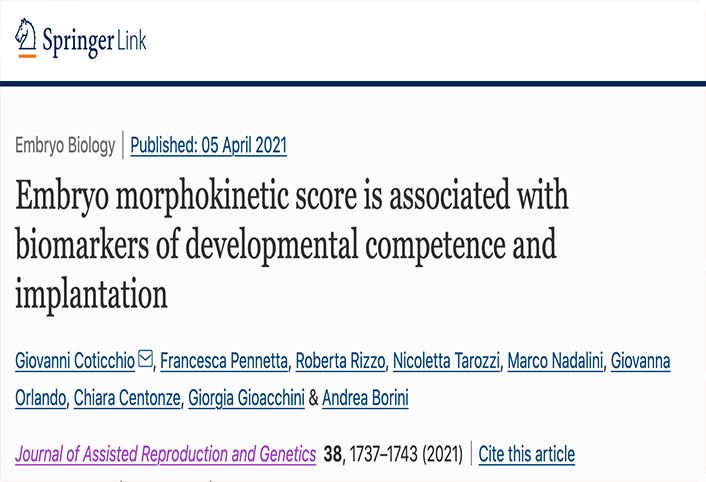
Embryo morphokinetic score is associated with biomarkers of developmental competence and implantation
Giovanni Coticchio, Francesca Pennetta, Roberta Rizzo, Nicoletta Tarozzi, Marco Nadalini, Giovanna Orlando, Chiara Centonze, Giorgia Gioacchini, Andrea Borini
J Assist Reprod Genet 2021 Jul;38(7):1737-1743 – doi: 10.1007/s10815-021-02162-9. Epub 2021 Apr 5
Abstract
Purpose
To study embryo morphokinetics in relation to release in spent media of molecules with possible roles in development and implantation (miR-20a, miR-30c, and sHLA-G).
Methods
Data were obtained from embryos generated in standard IVF and ICSI cycles. The Eeva system was used for embryo assessment, based on early morphokinetic parameters and producing a score (1–5, best–worst) corresponding to higher/medium/lower chances of development to blastocyst. miRNAs — mm miR-20a-5p and miR-30c-5p — and sHLA-G were quantified in 25 μl of spent blastocyst media (SBM) collected before vitrification or transfer. Statistical analyses were performed applying Kolmogorov-Smirnov, Shapiro-Wilk, and Spearman’s correlation coefficient tests, where appropriate.
Results
SBM were collected from a total of 172 viable blastocysts. Their analysis showed that concentration of miR-20a was progressively lower as Eeva score increased and probability of development to blastocyst decreased (P = 0.016). The opposite trend was observed in the case of miR-30c, i.e., concentration was higher as score increased and chances of development to blastocyst decreased (P = 0.004). Analysis of sHLA-G revealed a negative correlation with Eeva score, i.e., levels were progressively lower as Eeva score increased and probability of development to blastocyst decreased (R = − 0.388, N = 141, P = 0.001).
Conclusion
Our data suggest that morphokinetic algorithms that predict development to blastocyst stage, in fact, also identify embryos with molecular and cellular profiles more consistent with developmental functions.
